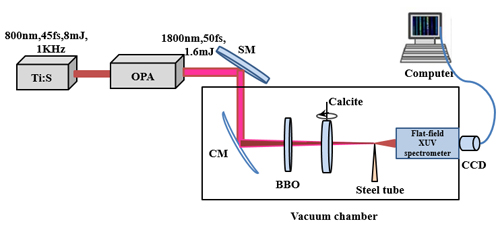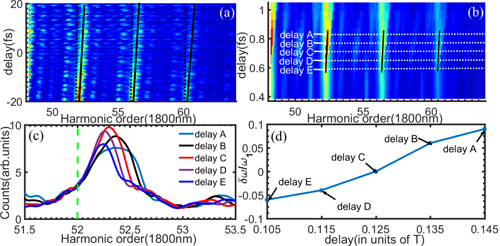High-order harmonic generation (HHG), a highly nonlinear interaction of intense light with matter, has been extensively investigated during the past few decades since its first discovery. Due to the high degree of nonlinearity, the high harmonic spectra will exhibit strikingly complicated features, one of which that has been widely investigated is the frequency modulation, which includes the blueshift induced by the self-phase modulation (SPM) during propagation and the frequency shift induced by the nonadiabatic effect of the intensity-dependent intrinsic dipole phase. Previous studies have utilized extremely intense single color near-infrared 800nm field to study the frequency modulation of HHG, but the microscopic processes are not easy to be fine controlled.
In this work, we have experimentally investigated the frequency modulation of high-order harmonics in an orthogonally polarized two-color (OTC) laser field consisting of a mid-infrared (MIR) 1800nm fundamental pulse and its second harmonic pulse, and accomplished continuous and fine-tuned frequency modulation of high harmonic spectra simply by slightly change the relative delay of the two-color laser pulses. By analyzing the relative frequency shift of each harmonic at different two-color delays, the nonadiabatic spectral shift induced by the rapid variation of the intensity-dependent intrinsic dipole phase can be distinguished from the blueshift induced by the change of the refractive index during self-phase modulation (SPM).Theoretical analyses show that our MIR-OTC scheme may enable the steering of electron trajectory selection and control of the relative contribution of the leading and trailing parts of high harmonic emission. This provides us a simple method to control the HHG process and fine-tune the harmonic spectra on a sub-cycle time scale.
This work was supported by the National Natural Science Foundation of China, the 973 Project and Shanghai Commission of Science and Technology.
This study entitled ’’Frequency modulation of high-order harmonic generation in an orthogonally polarized two-color laser field” was published on Optics Express on August 4, 2016.
[https://www.osapublishing.org/oe/fulltext.cfm?uri=oe-24-16-18685&id=348323]

Fig. 1. Experimental setup. SM: silver mirror; CM: concave mirror; BBO: barium borate crystal; CCD: charge coupled device.

Fig.2. (a) Experimental harmonic spectra as a function of the two-color delay within -20fs~20fs obtained by the MIR-OTC scheme from Ar. (b) Enlarged spectra in (a) with the two-color delay ranging from 0.4fs~1fs. (c) Fine spectral structure of H52 at delay A, delay B, delay C, delay D and delay E, corresponding to the two-color delays of 0.145T, 0.135T, 0.125T, 0.115T and 0.105T,respectively. (d) The relative spectral shifts of H52 by taking the spectrum of delay C as a reference.







